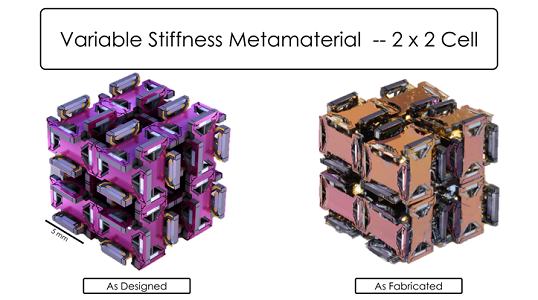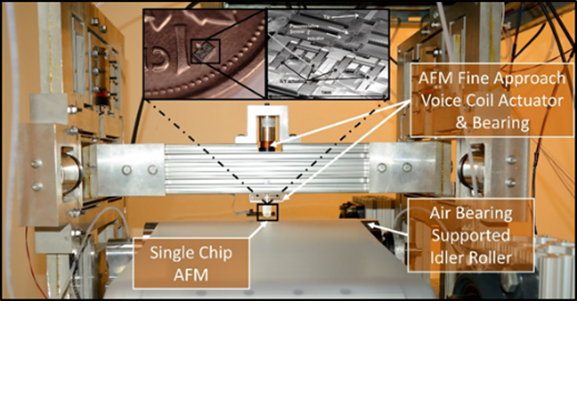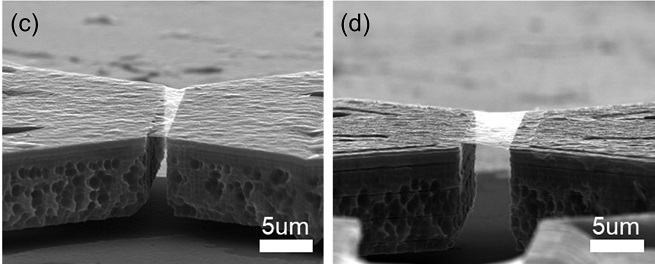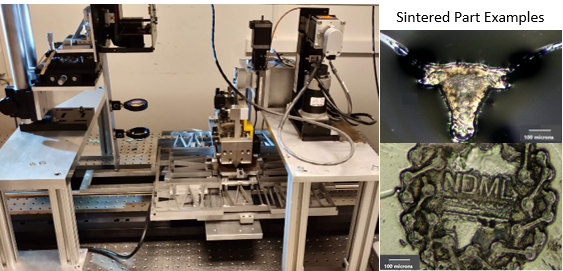The development of micro and nanoscale additive manufacturing methods in metals and ceramics is important for many applications in the aerospace, medical device, and electronics industries. For example, if we can fabricate additively manufactured parts with micron-scale resolutions, it becomes possible to produce materials with controlled microstructures. Such materials can exhibit very high strength-to-weight ratios, which is critical for a number of applications in the aerospace industry. Similarly, the medical industry could benefit from the additive manufacturing of metal parts with controlled microstructures since this process could be used to fabricate custom implants with enhanced surface structures to either promote or prevent the adhesion of cells to the implant in specific areas. Unfortunately, most commercially available metal additive manufacturing tools have feature-size resolutions of greater than 100 μm, which is too large to precisely control the...
You are here
Research
Research in the NDML focuses on developing the nanomanufacturing tools necessary to scale up the production of nanomaterials, nanostructures, and nanosystems from the fabrication of bench-level test structures to the high-volume production of low cost, high precision sensor systems. We do this by focusing on three key areas in the development of nanomanufacturing systems: (1) the design of novel nanomanufacturing processes and equipment to improve production rate and quality; (2) the establishment of improved design rules and techniques to increase the manufacturability of nanoscale devices; and (3) the development of new assembly and fabrication methods to improve the integration of nanomaterials into micro/macroscale devices. Through these focus areas we hope to substantially improve the cost, quality, rate, and flexibility of nanomanufacturing systems and expand the role of nanoscale systems in our society. We believe that this type of expansion in the use of nanotechnology could help lead to a healthier, safer, more productive society.

Decades of sustained scaling in IC fabrication has made it possible to obtain extremely high functionality in increasingly smaller die and the proliferation of mobile computing is creating a need for compact, heterogeneous integration of materials and functionalities. These emerging trends have led to great deal of interest in the large scale manufacturing of flexible hybrid nanoelectronic devices. Efforts in this area within the NDML focus on two key technologies: (1) The exfoliation of thin silicon films from bulk silicon wafers and (2) The assembly of micron scale chiplets at extremely high rates into 3D nanoelectronic structures. The combination of the wafer exfoliation technology with the ability to assemble micron scale chips at very high rates will enable the cost-effective manufacturing of 3D nanoelectronic systems with unprecedented heterogeneous functionality in extremely compact form-factors for applications in mobile computing, wearable electronics,...

The third area of focus for the NDML is the development of metrology systems for nanomanufacturing applications. One of the major challenges in nanoscale manufacturing is defect control because it is difficult to measure nanoscale features in-line with the manufacturing process. Optical inspection typically is not an option at the nanoscale level due to the diffraction limit of light, and without inspection high scrap rates can occur. Therefore, the NDML has developed a roll-to-roll atomic force microscopy (AFM)-based inspection system that can be rapidly implemented in-line with other nanomanufacturing processes. In addition to in-line inspection systems, the NDML is also developing in-situ sensor systems that can help us gain a better understanding of various nanomanufacturing processes.

The final major focus of the NDML is the manufacturing of nanoscale materials and devices for nanoelectronics, structural, and sensing applications. One of the biggest current challenges in nanomanufacturing is the integration of nanomaterials and mechanisms with micro- and macroscale structures to create repeatable devices. This type of multi-scale integration is necessary because nanoscale materials and mechanisms typically need to interact with the larger world around them in order to produce useful devices and products. However, the three to six order-of-magnitude scale mismatch between the nano and the macro worlds can cause problems since small changes in force, displacement or temperature can have vastly different effects on nanoscale and macroscale structures. In addition, it is generally difficult to find micro- and macroscale tools that can be used to quickly and effectively manipulate nanoscale materials and mechanisms. Therefore, new methods such as...
